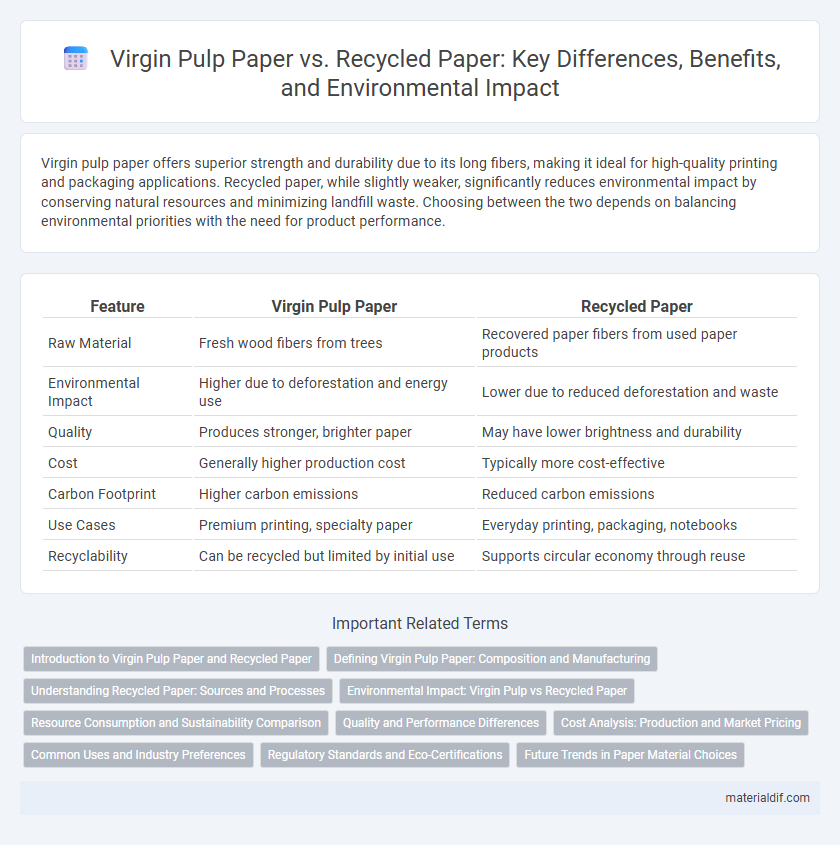Virgin pulp paper offers superior strength and durability due to its long fibers, making it ideal for high-quality printing and packaging applications. Recycled paper, while slightly weaker, significantly reduces environmental impact by conserving natural resources and minimizing landfill waste. Choosing between the two depends on balancing environmental priorities with the need for product performance.
Table of Comparison
| Feature | Virgin Pulp Paper | Recycled Paper |
|---|---|---|
| Raw Material | Fresh wood fibers from trees | Recovered paper fibers from used paper products |
| Environmental Impact | Higher due to deforestation and energy use | Lower due to reduced deforestation and waste |
| Quality | Produces stronger, brighter paper | May have lower brightness and durability |
| Cost | Generally higher production cost | Typically more cost-effective |
| Carbon Footprint | Higher carbon emissions | Reduced carbon emissions |
| Use Cases | Premium printing, specialty paper | Everyday printing, packaging, notebooks |
| Recyclability | Can be recycled but limited by initial use | Supports circular economy through reuse |
Introduction to Virgin Pulp Paper and Recycled Paper
Virgin pulp paper is produced directly from freshly harvested wood fibers, ensuring high strength, brightness, and purity, making it ideal for printing and packaging. Recycled paper is made from recovered fibers collected from used paper products, reducing environmental impact by conserving resources and minimizing landfill waste. Both types offer distinct advantages in sustainability, quality, and manufacturing processes.
Defining Virgin Pulp Paper: Composition and Manufacturing
Virgin pulp paper is produced from freshly harvested wood fibers, primarily derived from softwood and hardwood trees, which undergo chemical or mechanical pulping processes to separate cellulose fibers. The manufacturing involves bleaching to enhance whiteness and strength, ensuring high-quality, smooth paper suited for printing and writing applications. This paper exhibits superior durability, brightness, and printability compared to recycled paper, which contains a mixture of post-consumer fibers.
Understanding Recycled Paper: Sources and Processes
Recycled paper is primarily sourced from post-consumer waste, including used office paper, newspapers, and cardboard, as well as post-industrial scraps generated during manufacturing. The recycling process involves collection, sorting, de-inking, and re-pulping, which removes inks, adhesives, and contaminants to produce clean fibers suitable for new paper production. Utilizing recycled fibers reduces the demand for virgin pulp, conserves natural resources, and lowers energy consumption in paper manufacturing.
Environmental Impact: Virgin Pulp vs Recycled Paper
Virgin pulp paper production consumes significantly more water and energy compared to recycled paper, leading to higher greenhouse gas emissions and increased deforestation rates. Recycled paper reduces landfill waste and lowers the demand for virgin wood fibers, thus conserving biodiversity and decreasing carbon footprint. Choosing recycled paper supports sustainable forest management and resource conservation, making it a more environmentally responsible option.
Resource Consumption and Sustainability Comparison
Virgin pulp paper production demands significantly higher water and energy consumption compared to recycled paper, intensifying resource depletion. Recycled paper reduces reliance on fresh wood fibers, preserving forest resources and lowering greenhouse gas emissions. Sustainability metrics favor recycled paper for minimizing environmental impact through decreased landfill waste and energy-efficient manufacturing processes.
Quality and Performance Differences
Virgin pulp paper consistently delivers superior strength, brightness, and durability compared to recycled paper due to its intact fiber structure and minimal processing. Recycled paper fibers are shorter and weaker from multiple processing cycles, resulting in reduced tear resistance and print quality. Industrial applications requiring high-quality print and structural integrity heavily favor virgin pulp paper for its reliability and enhanced performance metrics.
Cost Analysis: Production and Market Pricing
Virgin pulp paper generally incurs higher production costs due to extensive raw material processing and energy consumption compared to recycled paper, which utilizes reclaimed fibers and reduces resource dependency. Market pricing reflects these cost differences, with virgin pulp paper typically commanding a premium price driven by superior strength and quality attributes. Recycled paper offers a cost-effective alternative, balancing lower production expenses with increasing consumer demand for sustainable products.
Common Uses and Industry Preferences
Virgin pulp paper is predominantly favored in high-quality print products like books, premium packaging, and archival materials due to its superior strength, brightness, and durability. Recycled paper is extensively used for everyday printing, newspapers, and packaging applications where cost-efficiency and environmental sustainability are prioritized over premium appearance. The paper manufacturing industry increasingly balances these options, with virgin pulp preferred for specialty products and recycled fiber dominating mass-market and environmentally focused paper goods.
Regulatory Standards and Eco-Certifications
Virgin pulp paper and recycled paper are both subject to stringent regulatory standards such as the Forest Stewardship Council (FSC) and Programme for the Endorsement of Forest Certification (PEFC), ensuring sustainable forestry and environmentally responsible production practices. Virgin pulp paper often complies with regulations concerning deforestation and chemical use under international frameworks like the EU Timber Regulation (EUTR), while recycled paper emphasizes standards related to waste management and contamination control. Eco-certifications like Blue Angel and EcoLabel further validate the environmental credibility of recycled paper by highlighting reduced carbon footprints, energy consumption, and water usage compared to virgin pulp alternatives.
Future Trends in Paper Material Choices
Virgin pulp paper, sourced directly from sustainably managed forests, offers superior strength and brightness, making it ideal for high-quality print applications. Recycled paper, composed of recovered fibers, continues to advance with improved deinking techniques and fiber recovery rates, enhancing its environmental appeal and performance. Future trends favor hybrid paper materials blending virgin and recycled fibers, optimizing durability while minimizing ecological impact in the paper industry.
Virgin Pulp Paper vs Recycled Paper Infographic

 materialdif.com
materialdif.com